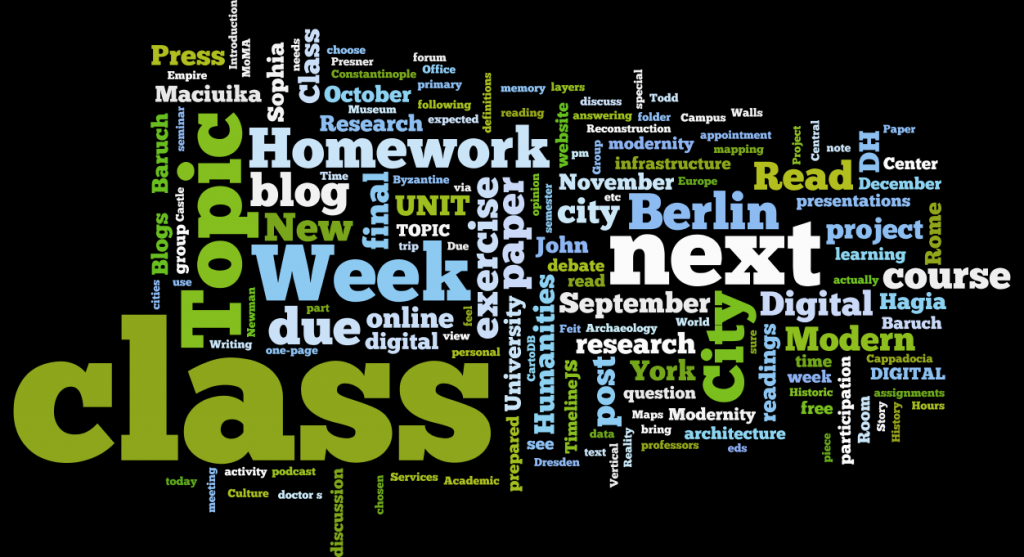Description
The essay was a response to an activity from my Fall 2015 course, Digital Humanities and the Modern City, in which the students were given agency to define digital humanities for themselves.
This assignment reflection was first disseminated on AHTR Weekly, a blog on the Art History Teaching Resources (AHTR) website which had more than 202,000 views, and 91,000 visitors from 185 different countries in 2015.

Citation
McMichael, A.L., “Collaborative Definitions,” in AHTR Weekly, Art History Teaching Resources, eds. Karen Shelby and Michelle Millar Fisher (December 4, 2015). [original post]
Essay
“What is DH? And what does it have to do with studying architecture and cities? (Write 1-2 paragraphs and be prepared to discuss in class).” For the first week’s homework, my co-instructor and I dropped these large questions at the feet of CUNY undergraduate students.
The course, “The Digital Humanities and the Modern City,” is an endowed Feit Interdisciplinary Seminar at Baruch College that I am co-teaching with John Maciuika (Professor, Baruch College and the CUNY Graduate Center). It’s unusual for a number of reasons—there are only 13 students, there are two instructors, and we could be reasonably sure about student buy-in regarding technology and access to equipment—allowing the nature of the class to be somewhat experimental. So instead of our introducing a codified explanation of Digital Humanities to the students (a feat that would, at best, take forever and be pretty complex), the assignment required them jump in and define “DH” without our oversight, and to bring some personal perspective to the table for discussion and debate. Because the course uses DH as a context for analyzing modern cities and the relative modernity of ancient places, we can be flexible. What we ask students to learn regarding technology must primarily feed their critical thinking about reconstruction, preservation, and modernization.
I imagine that this kind of self-defining activity could work just as well for a variety of topics beyond Digital Humanities. For instance, in a “Non-Western” art history course, I once began the semester with my own introduction to the topic, but I had the students spend the last day debating various alternatives to the phrase and reconsidering how the topics might have been introduced. How might discussions have been different if I had let the students lead the way toward how the lessons unfolded from day one? Feminism comes to mind as another area where students might productively wrestle with definition, as does civil rights, or even digital art history.
The week following the homework assignment, students were required to print their short response before class. I’ve found that in-class writing or printed homework bolsters confidence in class discussions, and it worked well here. We had a productive discussion that day, wherein both students and professors shared personal anecdotes about relationships to technology, quotes from practitioners, or reliable resources.
To follow up, we assigned several theoretical readings about our engagement with the digital, including an excerpt from Todd Presner’s book Hypercities: Thick Mapping in the Digital Humanities and NPR’s Invisibilia podcast, “Our Computers, Ourselves.” Students were also required to refine and edit their definitions before posting them to a class blog, with encouragement to reflect on how their opinion changed, what stood out from the discussion, or what new resources made an impact.
Then we (the professors) built our own introductions and subsequent tutorials as a semester-long conversation bouncing off the original. Instead of imposing our parameters (honestly, I’m not sure I even have a concrete definition myself!), we allowed definition to become a process rather than a product, letting the class brainstorm ways DH can/should/might relate to architecture and modernity.
From a pedagogical perspective this assignment addressed a handful of issues:
- We got a glimpse into their various research processes, writing abilities, and conversational skills early in the semester in a low-stakes situation.
- It was an important glimpse into what the field of DH looks like for non-practitioners or newly-introduced undergrads. I was particularly interested in seeing which names, themes, and sources were on their collective radar.
- It allowed us to meet the students where they were in terms of digital literacy and vocabulary, and to be more collaborative with them while incorporating DH into the course material.
A primary goal for the semester was to promote active engagement with the digital. In doing this, I wanted to help them conceive of humanities research as data. Subsequent projects were designed to incorporate digital tools and media in order to further arguments rather than simply as presentation tools or visual aids. Much of their enthusiasm and success toward those projects has come from their agency to adapt tools and aspects of digital scholarship into their own research process.
One outcome of letting students define the course subfield for themselves is that it drives home the experimental, mutable, and ever-changing nature of technology. Instructors in DH have to continually pivot and respond (to technical glitches, tailoring how-tos, being at the mercy of various tool developers and IT realities). An open conversation at the beginning of the semester allowed students to see this reality as a positive situation with potential, one in which they play an active role in tailoring technology to their own research needs.

